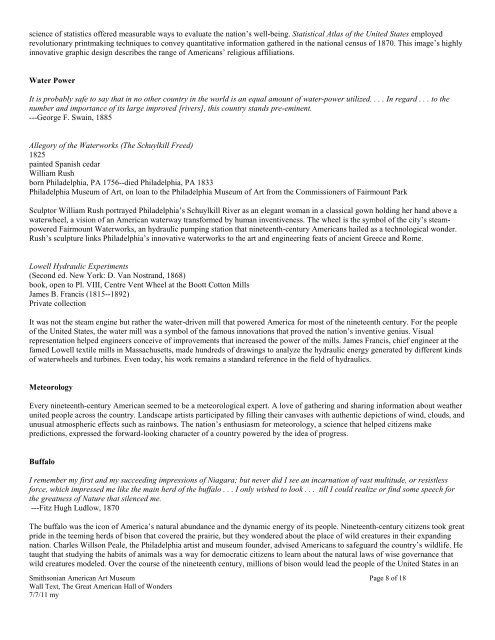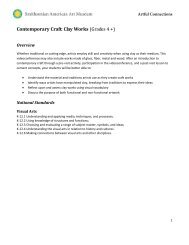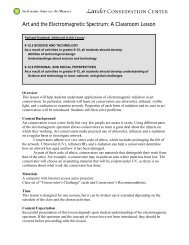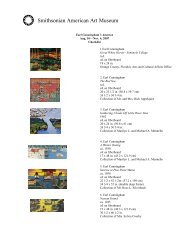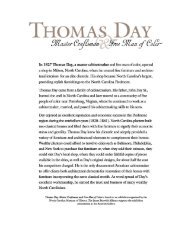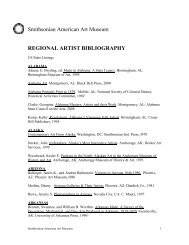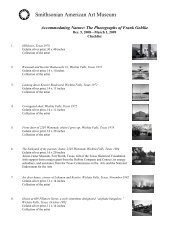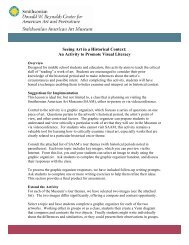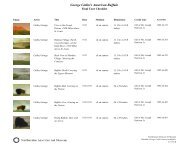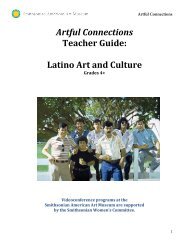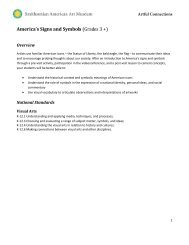Smithsonian American Art Museum - Smithsonian Institution
Smithsonian American Art Museum - Smithsonian Institution
Smithsonian American Art Museum - Smithsonian Institution
Create successful ePaper yourself
Turn your PDF publications into a flip-book with our unique Google optimized e-Paper software.
science of statistics offered measurable ways to evaluate the nation’s well-being. Statistical Atlas of the United States employed<br />
revolutionary printmaking techniques to convey quantitative information gathered in the national census of 1870. This image’s highly<br />
innovative graphic design describes the range of <strong>American</strong>s’ religious affiliations.<br />
Water Power<br />
It is probably safe to say that in no other country in the world is an equal amount of water-power utilized. . . . In regard . . . to the<br />
number and importance of its large improved [rivers], this country stands pre-eminent.<br />
---George F. Swain, 1885<br />
Allegory of the Waterworks (The Schuylkill Freed)<br />
1825<br />
painted Spanish cedar<br />
William Rush<br />
born Philadelphia, PA 1756--died Philadelphia, PA 1833<br />
Philadelphia <strong>Museum</strong> of <strong>Art</strong>, on loan to the Philadelphia <strong>Museum</strong> of <strong>Art</strong> from the Commissioners of Fairmount Park<br />
Sculptor William Rush portrayed Philadelphia’s Schuylkill River as an elegant woman in a classical gown holding her hand above a<br />
waterwheel, a vision of an <strong>American</strong> waterway transformed by human inventiveness. The wheel is the symbol of the city’s steampowered<br />
Fairmount Waterworks, an hydraulic pumping station that nineteenth-century <strong>American</strong>s hailed as a technological wonder.<br />
Rush’s sculpture links Philadelphia’s innovative waterworks to the art and engineering feats of ancient Greece and Rome.<br />
Lowell Hydraulic Experiments<br />
(Second ed. New York: D. Van Nostrand, 1868)<br />
book, open to Pl. VIII, Centre Vent Wheel at the Boott Cotton Mills<br />
James B. Francis (1815--1892)<br />
Private collection<br />
It was not the steam engine but rather the water-driven mill that powered America for most of the nineteenth century. For the people<br />
of the United States, the water mill was a symbol of the famous innovations that proved the nation’s inventive genius. Visual<br />
representation helped engineers conceive of improvements that increased the power of the mills. James Francis, chief engineer at the<br />
famed Lowell textile mills in Massachusetts, made hundreds of drawings to analyze the hydraulic energy generated by different kinds<br />
of waterwheels and turbines. Even today, his work remains a standard reference in the field of hydraulics.<br />
Meteorology<br />
Every nineteenth-century <strong>American</strong> seemed to be a meteorological expert. A love of gathering and sharing information about weather<br />
united people across the country. Landscape artists participated by filling their canvases with authentic depictions of wind, clouds, and<br />
unusual atmospheric effects such as rainbows. The nation’s enthusiasm for meteorology, a science that helped citizens make<br />
predictions, expressed the forward-looking character of a country powered by the idea of progress.<br />
Buffalo<br />
I remember my first and my succeeding impressions of Niagara; but never did I see an incarnation of vast multitude, or resistless<br />
force, which impressed me like the main herd of the buffalo . . . I only wished to look . . . till I could realize or find some speech for<br />
the greatness of Nature that silenced me.<br />
---Fitz Hugh Ludlow, 1870<br />
The buffalo was the icon of America’s natural abundance and the dynamic energy of its people. Nineteenth-century citizens took great<br />
pride in the teeming herds of bison that covered the prairie, but they wondered about the place of wild creatures in their expanding<br />
nation. Charles Willson Peale, the Philadelphia artist and museum founder, advised <strong>American</strong>s to safeguard the country’s wildlife. He<br />
taught that studying the habits of animals was a way for democratic citizens to learn about the natural laws of wise governance that<br />
wild creatures modeled. Over the course of the nineteenth century, millions of bison would lead the people of the United States in an<br />
<strong>Smithsonian</strong> <strong>American</strong> <strong>Art</strong> <strong>Museum</strong> Page 8 of 18<br />
Wall Text, The Great <strong>American</strong> Hall of Wonders<br />
7/7/11 my


